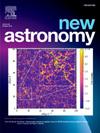具有三次曲率修正的爱因斯坦-以太引力中的暗能量参数化
IF 2.1
4区 物理与天体物理
Q2 ASTRONOMY & ASTROPHYSICS
引用次数: 0
摘要
我们在包含三次曲率修正的广义爱因斯坦-以太引力框架内研究了晚时宇宙加速度。采用cpl、JBP和BA三种常用的动态暗能量参数化方法,利用来自Pantheon的Ia型超新星(SN Ia)数据,通过χ2最小化方法,通过约束自由模型参数重建宇宙膨胀历史。我们确定模型参数的最佳拟合值,并评估关键的宇宙学量,如暗能量密度Ωde0、物质密度Ωm0、哈勃常数H0和当前宇宙的减速参数q0。我们还研究了代表暗能量的等效标量场的势能V(z)和动能φ(22)作为红移z的函数的演变。本文章由计算机程序翻译,如有差异,请以英文原文为准。
Dark energy parametrizations in Einstein–Aether gravity with cubic curvature corrections
We investigate the late-time cosmic acceleration within the framework of generalized Einstein-Aether gravity incorporating cubic curvature corrections. Employing three widely used dynamical dark energy parametrizations-CPL, JBP, and BA, we reconstruct the cosmic expansion history by constraining the free model parameters using Type Ia Supernova (SN Ia) data from the Pantheon compilations via a -minimization approach. We determine best-fit values for the model parameters and evaluate key cosmological quantities such as the dark energy density ,the matter density , the Hubble constant , and the deceleration parameter of the present universe. We also examine the evolution of the potential and the kinetic energy of the equivalent scalar field representing dark energy as functions of redshift .
求助全文
通过发布文献求助,成功后即可免费获取论文全文。
去求助
来源期刊

New Astronomy
地学天文-天文与天体物理
CiteScore
4.00
自引率
10.00%
发文量
109
审稿时长
13.6 weeks
期刊介绍:
New Astronomy publishes articles in all fields of astronomy and astrophysics, with a particular focus on computational astronomy: mathematical and astronomy techniques and methodology, simulations, modelling and numerical results and computational techniques in instrumentation.
New Astronomy includes full length research articles and review articles. The journal covers solar, stellar, galactic and extragalactic astronomy and astrophysics. It reports on original research in all wavelength bands, ranging from radio to gamma-ray.
 求助内容:
求助内容: 应助结果提醒方式:
应助结果提醒方式:


